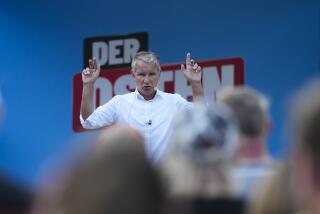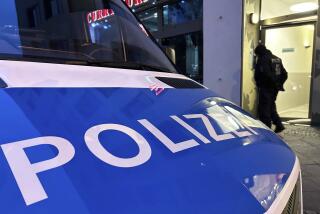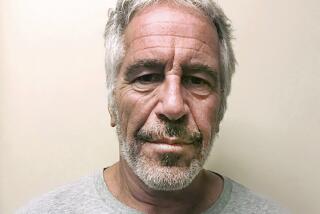From the archives: Key W. German Banker Killed in Car Bombing
BONN -- Alfred Herrhausen, the head of West Germany’s largest bank and one of the most powerful men in Europe, was killed in a bomb attack Thursday while he was en route to his office in Frankfurt.
The office of the chief federal prosecutor said that the Red Army Faction, a terrorist organization, had claimed responsibility for the attack in a letter left at the scene.
The blast that killed Herrhausen destroyed his armored BMW limousine and was heard as far as three miles away from Bad Homburg, a Frankfurt suburb where Herrhausen lived. His driver was severely injured.
The 59-year-old executive, a personal friend of Chancellor Helmut Kohl and an economic adviser to Kohl’s government, was on his way to his office at the Frankfurt headquarters of the Deutsche Bank, of which he was chief executive.
Kohl, when informed of the killing, denounced it as a “cowardly and brutal murder.” He described Herrhausen as a friend and patriot.
“Whoever knew him,” Kohl said, “knows he was an outstanding businessman, an important banker and one of the most important spokesmen for the German economy around the world.”
Foreign Minister Hans-Dietrich Genscher said Herrhausen had been “an eminent representative of responsible social and political policies in West Germany” and that he had “made a great contribution to aid programs for Third World countries.”
In Rome, a spokesman for Prime Minister Giulio Andreotti, who was meeting with Soviet President Mikhail S. Gorbachev, said “the prime minister and President Gorbachev expressed their regret at Herrhausen’s death.”
Herrhausen had strong ties to the Soviet Union and had recently made it clear that his bank was prepared to expand toward the East as a result of the decline in Communist power there.
On Monday he had flown to London to complete arrangements for the Deutsche Bank to take over the British merchant bank Morgan Grenfell, a move designed to expand the West German bank’s role in Europe.
But his status as West Germany’s No. 1 banker had drawn criticism from people who said they feared the power of the banks, and particularly that of the Deutsche Bank because of the latter’s interests in many important private companies, including key industrial enterprises.
The Deutsche Bank recently pressed for a merger between the auto maker Daimler-Benz AG, of which the bank is a major shareholder, and the aerospace concern Messerschmitt-Boelkow-Blohm (MBB). This role helped make Herrhausen a potential target for terrorists.
“Anything related to weapons,” a fellow banker said Thursday, “is seen by the general public as immoral.”
Heribert Hellenbroich, former head of West German counterintelligence, suggested that Herrhausen’s part in the Daimler-Benz-MBB arms industry merger could have drawn terrorist attention to him.
Moreover, for the extreme left wing, the largest West German bank and its chief executive were a symbol of the hated capitalist system.
“He (Herrhausen) is an unusual phenomenon in terms of what one expects from the chairman of Deutsche Bank,” the liberal weekly Die Zeit once commented. “He does not act like a traditional banker, but instead more like a captain of industry who by sheer force wants to transform his institution into a company with ‘international identity’ active in all areas of finance.”
Besides the bank’s industrial holdings in 1,700 West German and 200 foreign firms, Deutsche Bank under Herrhausen recently began moving into such new financial areas as insurance and mortgage banking.
The bombing attack occurred just after 8:30 a.m., about 500 yards from Herrhausen’s heavily guarded residence in Bad Homburg, a fashionable spa. As Herrhausen’s BMW moved along, followed by a vehicle carrying security personnel, an explosive device was detonated, apparently by remote control.
The car was thrown into the air. Its doors, hood and trunk flew open, and its windows were shattered. The force of the explosion knocked out the windows of homes and other buildings in a wide area.
Policemen found the letter claiming responsibility not far from the shattered car. It bore the Red Army Faction symbol of a Kalashnikov rifle superimposed on a star, but neither police nor the prosecutor’s office made public the letter’s details.
In Paris, the chairman of the Deutsche Bank’s French branch said that the Frankfurt office had been warned by West German anti-terrorist services of a possible attack.
“For several weeks security measures had been tightened at the Deutsche Bank’s headquarters in Frankfurt,” Hesse Zu Leiningen told French television.
Security sources here said the Red Army Faction, thought to have been all but extinct, was preparing “a new phase of its struggle.” Until Thursday’s incident, the group was not known to have mounted any such action for more than three years.
Herrhausen, tall and elegantly dressed, looked 10 years younger than he was. Fluent in English and other foreign languages, he went into banking after working in the energy field. He joined Deutsche Bank in 1969 and became its chief executive last year. He brought a modern management style to the bank, emphasizing not so much titles and seniority as ability and ideas.
Recently, he had sought to reduce Third World debt, specifically promoting a plan to give financial aid to Poland. He also was talking about establishing banking links in the Soviet Union. On Wednesday night the bank had given a dinner for a delegation of high-level Soviet officials.
The news of his death stunned the Frankfurt Stock Exchange. Trading was interrupted for a minute of silence.
The Red Army Faction dates back to the late 1960s, when it mounted the first of a series of attacks that made it one of the most notorious terrorist organizations on the Continent, targeting mainly industrial and economic leaders in an effort to destabilize the West German government.
In the early years it was known as the Baader-Meinhof Gang, after its founders Andrea Baader and Ulrike Meinhof. Both committed suicide in prison.
The gang caught the world’s attention on May 11, 1972, when it killed a U.S. Army officer and wounded 13 other persons in a bomb attack on the headquarters of the U.S. 5th Corps at Frankfurt.
In the course of the next 11 years, it occupied the West German Embassy in Stockholm in an effort to bring about the release of two prisoners; killed a number of West German officials, financial leaders and industrialists; hijacked a Lufthansa airliner to Somalia; attacked U.S. Air Force headquarters at Ramstein, and set off a car bomb at the Rhein-Main Air Base near Frankfurt.
In all, according to the authorities, the gang has been responsible for the deaths of more than 60 people.
BACKGROUND
The terrorist Red Army Faction grew out of West Germany’s student unrest of the late 1960s. Its depredations began with an arson attack on a department store for which Andreas Baader was arrested in 1970. He was freed by cohorts at gunpoint a few weeks later and went underground to form the Baader-Meinhof Gang. Its aims were violent overthrow of the West German social order, including “monopoly capitalism.” Gang members sought contact with Third World guerrilla movements and were trained by leftist Palestinian guerrillas. When its leaders were arrested in 1972, the group tried through terrorism to force the release of the jailed figures: Baader, Ulrike Meinhof, Gudrun Ensslin, Jan Carl Raspe and Holger Meins. Meinhof committed suicide in prison in 1976. And Baader, Ensslin and Raspe committed suicide in jail in October, 1977, after West German troops ended a Red Army Faction hijacking of a Lufthansa plane in Mogadishu, Somalia. The faction has remained isolated in society, with 20 to 30 men and women considered the current hard core. But it continues to find sympathizers who lobby for more rights for its jailed members. In recent years, the Red Army Faction has increased cooperation with terrorist groups in Italy, France, Belgium and Spain.
DEUTSCHE BANK: A PROFILE
Deutsche Bank is the largest bank in West Germany by a wide margin. Here are some facts and figures:
Its $175-billion volume of business ranks it No. 22 in the world.
It has 55,000 employees and 1,530 branches serving 7 million customers worldwide.
Deutsche Bank was founded 117 years ago in Berlin. After World War II, the Allies shut down its Berlin headquarters, and all of its branches in the Soviet-occupied sector of Germany were closed. In 1952, the bank was broken up into three separate banking institutions, but five years later, these were re-merged into a single Deutsche Bank, with headquarters in Frankfurt.
About 62% of its business and 83% of its earnings in 1988 were in West Germany, underscoring the bank’s strong influence in the economy and reflecting its powerful industrial holdings. The value of these holdings are estimated at more than $7.35 billion, including a 28.1% share of Daimler-Benz, West Germany’s largest company.
More to Read
Sign up for Essential California
The most important California stories and recommendations in your inbox every morning.
You may occasionally receive promotional content from the Los Angeles Times.










